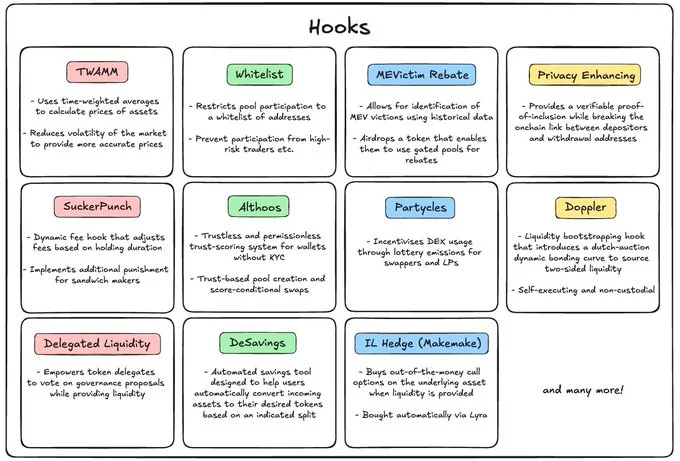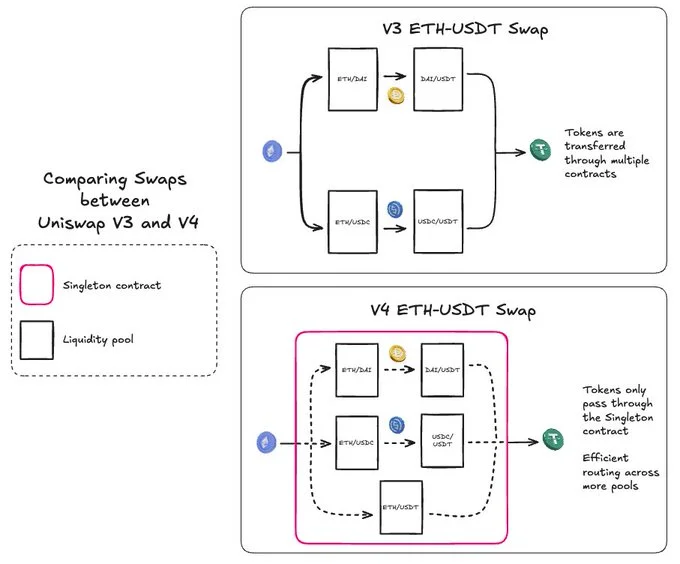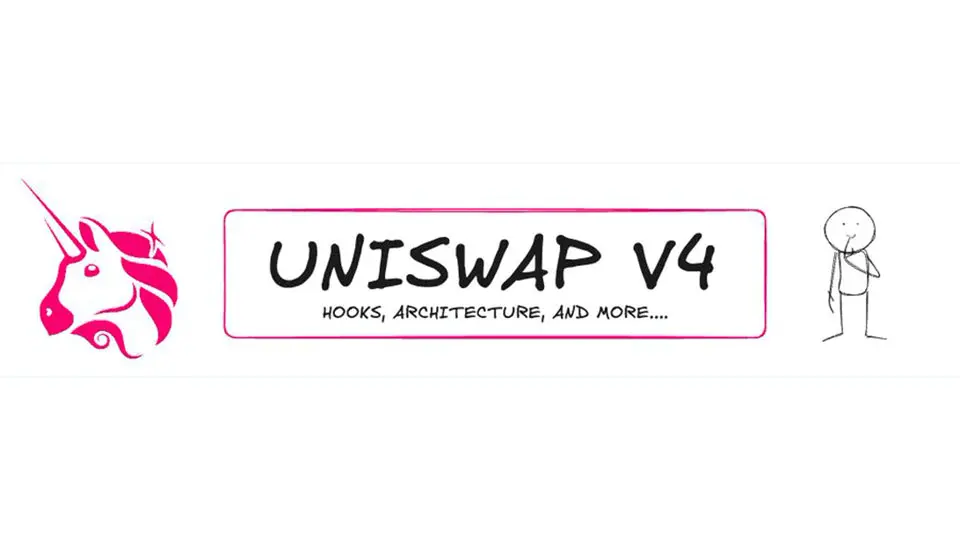Uniswap V4 launch is imminent, and new developments about to be brought by the new release are vividly discussed in the crypto community. We explain what V4 will change for liquidity providers (LP), traders, and what DeFi protocols are already building on V4’s technologies.
Uniswap V4: New Features Overview
Among the multitude of changes that Uniswap V4 introduces, there are a few aspects to take note of:
- Hooks.
- Flash Accounting System (FAS).
- Singleton Contract Model.
Let’s break down these technologies and explain their significance for various kinds of Uniswap and DeFi users.
Hooks
The first innovation we will review is hooks. In Uniswap V4, hooks are add-ons based on smart contracts that provide developers with the flexibility to customise actions at various stages of a transaction.
Using hooks to implement specific functionalities before and after swaps or liquidity adjustments, developers can unlock a wide range of possibilities for creating unique, tailored interactions within the protocol.
Some examples of features enabled by hooks include dynamic fees, automated yield strategies, time-based liquidity incentives, or risk management controls. All this enriches the overall user experience.
For liquidity providers (LPs) and traders, hooks create new profit opportunities: they can customise strategies and automated actions, which were previously challenging or impossible to execute within standard Automated Market Maker (AMM) frameworks used in DeFi and decentralised exchanges (DEXs), in particular.
With close to 100 different hooks listed on a dedicated web resource, we selected the most interesting ones in the graphic below:

Besides the tech itself, Uniswap launched Hook Incubator to support the development of diverse hook-based applications that expand the overall potential of DeFi.
Flash Accounting System (FAS): Better Gas Efficiency
The Flash Accounting System (FAS) in Uniswap V4 is designed to streamline asset transfers and reduce gas costs during transactions. Unlike V3, where assets are transferred in or out of pools at every swap, FAS allows for token transfers only on net balances, only once at the end of a transaction.
This tech reduces redundant pool operations and enhances gas efficiency for users, bringing more potential for high-frequency trading (HFT) of cryptocurrencies to the Uniswap protocol. In addition, FAS decreases the cost of liquidity fragmentation when combined with the next feature, singleton.
Singleton Contract Model: One Contract to Rule All Pools
While all liquidity pools are essentially separate contracts in Uniswap V3, V4 introduces the so-called singleton contract, responsible for deploying and managing all pools at once.

The “singleton” contract is expected to reduce gas required to deploy pools by 99%. Furthermore, this new design enables faster feature updates and greater flexibility, as new functionalities can be implemented across all Uniswap pools simultaneously.
For Uniswap users, the use of the “singleton” contract means swaps will no longer require transferring tokens between pools held in different contracts, making trades and routing between multiple pools more efficient.

Uniswap V4: Noticeable Protocols
Bunni
With the upcoming Uniswap V4, there are a couple of protocols that make use of new features to expand possibilities within the DeFi space. One of them is Bunni, which focuses on delivering features that target pitfalls of the existing CLAMM model.
CLAMM stands for Concentrated Liquidity Automated Market Maker. This model saw the light with the release of Uniswap V3, allowing LPs to concentrate their liquidity within specific price ranges, instead of spreading it evenly across all prices.
Whereas CLAMM provides higher capital efficiency, it has certain limitations. Liquidity management became more complex, the risk of permanent loss surged, and position adjustments incurred additional fees.
Bunni addresses CLAMM flaws by introducing several novel techniques, such as autonomous management of liquidity shapes, making liquidity providers (LPs) maintain effective positions without constant adjustments. It means that assets that would otherwise be out-of-range are used in other protocols to generate additional yield, enhancing overall returns.
Additionally, Bunni recaptures Maximal Extractable Value (MEV) by redistributing value traditionally extracted by miners or validators back to LPs, helping to mitigate MEV’s impact on profits. Together, these features simplify liquidity management, boost yield on idle assets, and improve profitability for LPs in a CLAMM model.
Silo Finance
Leveraging V4’s hooks, Silo Finance allows for permissionless deployment of isolated lending markets (silos) with extended functionalities.
Each silo acts as a standalone lending pool, which isolates risk so that issues in one market don’t affect others. Using hooks, these silos can be deployed in a permissionless manner, meaning anyone can create a lending market for any asset without requiring approval. This setup ensures tailored risk management while enhancing accessibility and flexibility in lending markets.
Think minting stablecoins within markets, deploying idle liquidity externally, and filtering poor credit borrowers. Multiple silos are already deployed in Silo Finance, with the TVL exceeding $85 million as of September 24, 2024.
Overall
In this article, we reviewed some of the most transformative features of Uniswap V4, which, combined, enhance customisation, reduce costs, and streamline liquidity management. These innovations benefit both liquidity providers and traders, enabling more efficient swaps, dynamic strategies, and better risk management options. DeFi protocols like Bunni and Silo Finance are already building on these features to address challenges of the existing protocol. Together, the new version of Uniswap promises to keep its role as a leading infrastructure provider for decentralised finance.
If you are building hooks or protocols around Uniswap V4 and are searching for a crypto venture capital partner, feel free to reach out to DWF Ventures.
